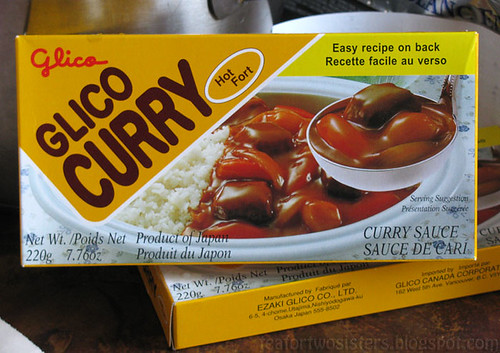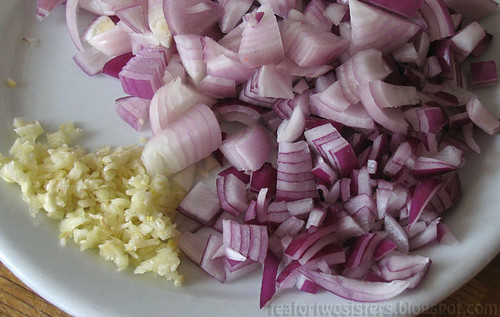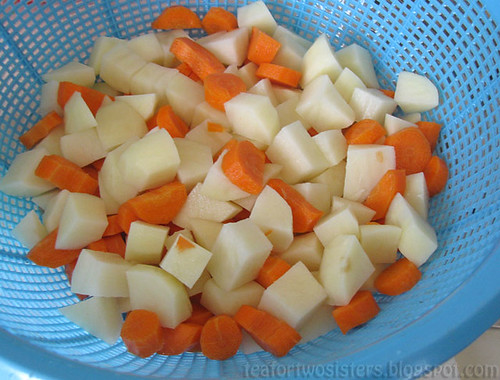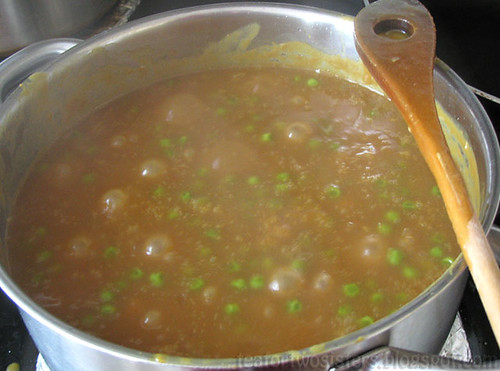
To this?

It takes at least 20 minutes of prep, less than 10 minutes of real cooking, and hours of simmering. I’ve noticed that every time I make Japanese curry (also known as “kare raisu”), I end up exhausted in a messy kitchen and with absolutely no appetite for the meal. Lucky for me, there are always hungry mouths in the house, so this dish didn’t go to waste.

I started with the onions and garlic. I minced two or three cloves of garlic, and finely chopped two medium onions.

Then I worked on the vegetables. We had potatoes and carrots, so I chopped them into cubes. They should only be about half the size of your thumb (in terms of length) to ensure that it cooks quickly and absorbs the curry flavour as it simmers. Any smaller would have them disintegrate in the curry and larger would mean giant chunks of bland (and possibly undercooked) vegetables.

Christine chopped up the chicken into bite-sized pieces. We used boneless, skinless chicken thighs, and as you can see here, there’s quite a bit of fat still on it. If I were using this for a stir-fry, I would meticulously cut the fat off, but in a dish where I use very little fat, the chicken benefits from having a bit of fat stuck to it. I’ve made the dish with chicken breast before, and it was dry and tasteless. There wasn’t enough fat in the chicken to withstand the hours of simmering, so it simply overcooked.
Now, I want to be perfectly clear that I cook according to how I feel. I often change the order of ingredients going into the pot, but the results are fairly consistent. I normally start with a sauté of onions and garlic, but this time, I knew I needed the curry to cook quickly for the empty bellies.
I started with heating about two tablespoons of oil in a large pot. Then I put in the chicken with a sprinkle of salt and stir-fried it until it was half-cooked. I added the onions first with another sprinkle of salt, waited until they softened, and then the garlic. I added garlic after the onions because it burns faster.
After it became aromatic, I tossed in the carrots, potatoes, and a pinch of salt. I’ve been adding small amounts of salt each time I introduce a new ingredient. It helps me control the amount of salt I use, and it ensures that the food is properly seasoned.
I stir-fried the ingredients for another minute or two before adding three cups of water. I made sure that it was just enough to cover the ingredients. I brought the mixture up to a boil, and dissolved the curry blocks. How many curry blocks? Enough to make the sauce opaque. This time, I used an entire box (family-sized) and two blocks.

I lowered the heat to a slow simmer, and stirred in about one cup of frozen peas. I add this last so that the peas don’t get overcooked and mushy. Normally, I’d also gently stir in some medium tofu, but the grocery store didn’t seem to have any that day.

As long as this mixture is simmered for at least half an hour, it’s ready to eat. You’ll notice, however, that it tastes best the next day after the ingredients have been absorbing the curry flavours overnight. That’s pretty much it!
My family didn’t love the curry as much as I’d hoped. My parents found it overly thick and sweet in comparison to other Southeast Asian curries. They also hoped it would be spicier. I was disappointed in their disappointment. This is the first year I’ve actually cooked regularly for my family, instead of cooking for Jimmy and myself, so I’m starting to get used to their palates and preferences. I should have known that this wouldn’t suit their tastes, but I’m just happy that they ate a bowl of it without much complaint.
Jimmy and my brother, on the other hand, cleaned up the pot themselves. They ate it every day, for three days straight. The smell was nauseating to me after the first day, so I cannot comprehend how they still managed to enjoy kare raisu after three days! Having them around to devour my meals is a real confidence booster, haha. Anyway, since there was lukewarm reception to the dish, I don’t anticipate I’ll be making it again anytime soon, so this will probably be the last post on kare raisu for a long time. Fret not, there will be more recipe posts coming up in the next few weeks!
My Japanese mother never used the curry roux. She'd use the S&B curry powder and brown her own flour in a skillet. The only fat came from whatever meat was being used. She also never sweetened the curry in any way. She would make it like typical kare-raisu which always reminded me of meat stew seasoned with curry. My favorite was with lamb. She would sometimes omit the potatoes and use other vegs such as eggplant, green beans, okra, and even some cabbage. Since we liked our food on the spicy side, she would add white or black pepper and red chili flakes. She sometimes even sprinkled toasted sesame seeds on the top when serving. That was a nice touch. My father would add Tabasco to his which I tried and liked at age 10. I always had a spicy palate:) I just made a small batch of beef curry with red and green peppers, no potato. I even made my own curry powder for it from scratch. I used browned rice flour to thicken since I have to be gluten-free. Kare-raisu is definitely comfort food for me. I remember a lot of chilly damp nights when a serving of it would warm your soul! Thanks, Mom! IMO of Kazuko Niwa, 1934-2000.
ReplyDeleteHi Chieko, thanks for your comments! We never had Japanese curry when we grew up. I'm not surprised that the curry cubes are sweet. It's probably like pho in restaurants. The soup is always unnecessarily over sweetened. What kind of curry powder did you make?
ReplyDeleteI too have made this recipe pretty much the same way as this, and also having a spice loving palate I found I had to kick it up a bit with a (bottled) hot sauce.
ReplyDelete